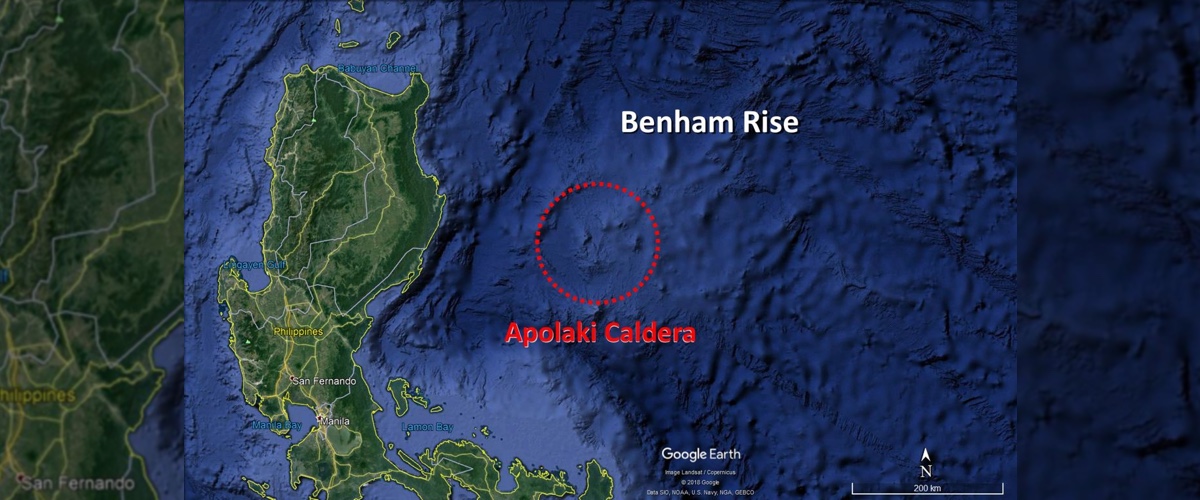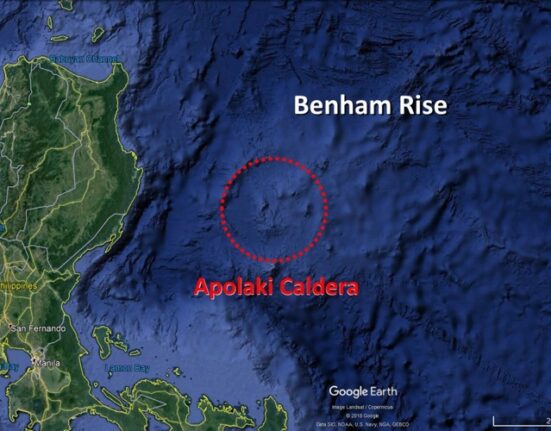WITH all the recent disasters, including a string of earthquakes, happening in the country, Filipinos could not help but feel scared and worried about their safety.
Netizens are now using social media to raise awareness about the importance of preparing for disasters and emergencies that could happen.
While doing so, some tend to share fearmongering posts or exaggerated information that only causes fear and anxiety among people without verifying the facts.
Case in point: the viral artificial intelligence (AI)-generated photo of the Apolaki Caldera, considered to be “the world’s largest known caldera,” found in the Philippine Rise (formerly Benham Rise), which is causing panic among netizens.
But should the Apolaki Caldera really be a cause of concern, given the series of powerful earthquakes that have recently struck the Philippines?
Filipina geologist Jenny Anne Barretto, who is part of a team of marine geophysicists that discovered the existence of the Apolaki Caldera, dismissed claims that it could erupt in the coming years, stressing that it has been “extinct” for millions of years.
The ‘world’s largest caldera’
Now based in New Zealand, Barretto and two other scientists made their discovery about the Apolaki Caldera public through their research paper titled “Benham Rise unveiled: Morphology and structure of an Eocene large igneous province in the West Philippine Basin.”
The 2019 study, which discussed the morphology and formation of the Philippine Rise, found that the Apolaki Caldera has a diameter of 150 kilometers (km), making it the world’s largest known caldera.
According to the National Geographic Society, a caldera refers to a large depression created after a volcano erupts and collapses. While calderas are often associated with major eruptions, the organization noted that slower eruptions can still form this cauldron-shaped depression.
The UP Marine Science Institute (UPMSI) compared Apolaki Caldera with the famous Yellowstone Caldera in Wyoming, which is only about 60 km wide.
It added that the Apolaki Caldera in the Philippine Rise is comparable to shield calderas found in Mars and Venus, such as Olympus Mons and Sacajawea, respectively.
In their paper, Barretto and her team said the area “underwent multiple collapse events and a phase of resurgence.”
“Its ~150 km diameter indicates an equally sized, relatively fixed, shallow magma chamber,” the paper read.
The researchers also named the caldera Apolaki, which means “giant lord.” In Philippine mythology, Apolaki is known as the god of the sun and war.
‘Extinct,’ not ’sleeping’ giant
While the Apolaki Caldera exists, Barretto said there is no reason to be scared of it now or in the future because it is no longer active.
“Mali ‘yung kumakalat na balita na ang Apolaki ay sleeping giant. Hindi siya sleeping, siya ay extinct. So ibig sabihin, hindi na ito puputok,” Barretto told DZRH News on Tuesday, October 14.
Barretto has been calling out fake news about the Apolaki Caldera on Facebook, particularly the AI-generated photos showing the Philippine archipelago beside a huge glowing ring. She pointed out that the caldera was not as massive as portrayed in the AI-generated image.
The geophysicist also clarified that the Apolaki Caldera is not a volcano.
“Ito ay caldera, so, siya lang ay bunganga ng bulkan. Ang totoong bulkan ay si Benham Rise, o Philippine Rise na tinatawag natin ngayon,” she explained.
“Ang Apolaki ay isa lamang sa mga bunganga ng bulkan na Benham Rise o Philippine Rise. It just so happened na si Apolaki Caldera, siya ‘yung pinaka malaking bunganga o crater sa Benham Rise at apparently, sa alam natin, sa buong mundo ngayon,” she added.
Based on studies about the Philippine Rise, Barretto mentioned that the age of volcanic rocks dredged from the Apolaki Caldera is more than 20 million years ago.
“Ang edad ng Benham Rise ay bumabata as you go from the southwest to the northeast. So ibig sabihin, ‘yung lugar kunwari ng Apolaki Caldera, mas matanda ‘yan kumpara doon sa nasa dulo sa northeast,” she said.
According to her research paper, the Philippine Rise is at the western margin of the Philippine Sea.
“Nasa 40 pa nga eh, 40 million years ago [‘yung mga bato], doon sa portion ng Apolaki,” Barretto emphasized.
“‘Yung pinakabatang volcanic rock na nakuha sa Benham Rise ay nasa 26 million years old. So whether ‘yung matanda na portion or ‘yung bata na portion ng Philippine Rise, sobrang tanda na, at base diyan, masasabi natin na ito ay extinct na,” she continued.
Department of Science and Technology (DOST) Secretary Renato Solidum Jr. had the same explanation in an interview with Super Radyo DZBB on Monday.
“Ang Benham Rise ay isang volcanic plateau na nagsimulang sumabog 47 million years ago, hanggang mga 26 to 27 million years ago. Ibig sabihin, extinct volcano po ‘yan at hindi na po ‘yan sasabog,” Solidum said.
He advised the public not to believe false information circulating about the Apolaki Caldera on social media.
Information about the Apolaki Caldera floated anew on social media as the Philippines continues to experience powerful earthquakes, including the 6.9 magnitude quake that struck Bogo City in Cebu and the “doublet earthquake” that jolted Davao Oriental recently.
Filipinos are constantly reminded of the safety tips on what to do before, during, and after an earthquake. They are also advised to prepare emergency go bags that contain essential items for survival, such as ready-to-eat food, drinking water, clothes, hygiene kits, and medical supplies.
How useful was this post?
Click on a star to rate it!
Average rating 0 / 5. Vote count: 0
No votes so far! Be the first to rate this post.
We are sorry that this post was not useful for you!
Let us improve this post!
Tell us how we can improve this post?









